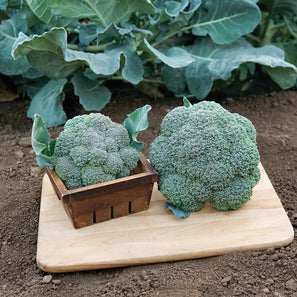APOLLO
Product Description:
| Soil Temp for Germ | 55–75°F |
| Seed Depth | ¼" |
| Seed Spacing | 4–6" |
| Days to Emergence | 5–17 |
| Thin Plants to | 12–24" |
| Row Spacing | 18–36" |
| Fertilizer Needs | High |
| Minimum Germination | 80% |
| Seeds per Gram | ≈ 250–350 |
| Seed Life | 3 years |
Brassica oleracea, Botrytis Group. Broccoli is a rich source of vitamins C, K, and B-complex, along with a treasure trove of minerals. Although one cup of milk has more calcium than a cup of broccoli, the human body absorbs the calcium from broccoli more effectively than from milk. From your body's perspective, broccoli is said to be richer in calcium than milk!
Days to maturity are calculated from date of transplanting; add 25-35 days if direct seeding.
Culture
• Broccoli performs best in fertile, well-drained soil with a pH of 6.0-7.0
• Broccoli is a cool-season crop that does not tolerate extreme heat; rough heads or leaves in the head are usually from heat stress
• Keep beds evenly moist and/or use shade cloth to maintain quality during heat waves
• Excess nitrogen or a boron deficiency can cause hollow stem
• In colder climates covering with Reemay or Frost Blanket will protect plants from frost damage
• Sprouting broccoli is very hardy, surviving down to 10°F — before flower buds open, cut the central head at a 45° angle; side shoots will form from the axillary buds
Direct Sowing
• Direct seed April through June
• At the bottom of the furrow band 1/2 cup of TSC's Complete fertilizer per 5 row feet
• Cover with loose soil or sifted compost
• Not recommended for fall plantings
Transplanting
• Not recommended for broccoli raab
• Start broccoli indoors 4-6 weeks before your anticipated transplant date
• Side dress with 1/2 cup of TSC's Complete fertilizer at transplant
• Start autumn/overwintering varieties May—July for transplanting June—August
• Start overwintering sprouting broccoli from mid-May—June, transplant out by the end of July—September
Insects & Diseases
• Common insects: See Brassica Insect Information below
• Disease prevention: 5-7 year crop rotation
Harvest & Storage
• Harvest when heads are tight and dense
• Cut side-shoots regularly to encourage production
• Store at 36°F and 100% relative humidity
Brassica Insect Information
Aphids: Control aphids with ladybugs or a hard spray of water or Pyrethrin. Also, select varieties that mature later in the season when aphid populations decline.
Cabbage worms, loopers, and root maggots: The first sign of cabbage worms will be off-white butterflies fluttering near the plants. They lay their yellowish-colored eggs on the undersides of leaves, which hatch into caterpillars that can cause severe root and head damage. To control light infestations, spray plants with Bacillus thuringiensis (B.t.). For heavy infestations, bait cabbage worms by mixing wheat bran into a B.t. solution. Add 1 tablespoon of molasses. Broadcast the bran mixture around the base of plants. Reapply as necessary. Using Reemay or Summer Insect Barrier can also provide control.
Flea beetles: Flea beetles chew tiny pinholes in leaves. Early control is essential to minimize the damage. Spray infected plants with Pyrethrin. Using floating row covers such as Summer Insect Barrier can also provide control.
Symphylans: In some areas of the US, symphylans (also known as garden centipede) can severely impede the plant growth of many crops. Only 1/4 inch long, white, and very active, they eat the root hairs of developing plants. Using larger transplants helps reduce damage. Contact your local county extension agent if you suspect you have a problem.
KEY TO BROCCOLI DISEASE RESISTANCE AND TOLERANCE
HR indicates high resistance.
IR indicates intermediate resistance.
BLS | Bacterial Leaf Spot
BR | Black Rot
DM | Downy Mildew
F | Fusarium Wilt







